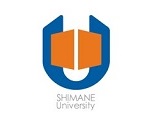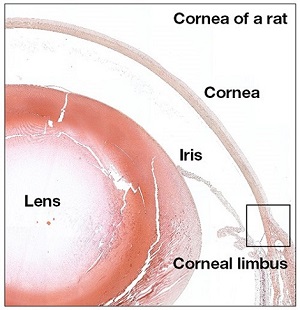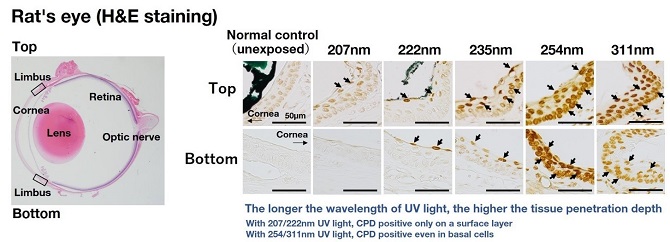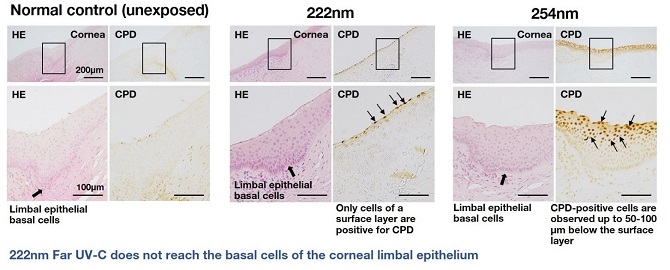公開日 2023/02/10



the group of researchers led by Professor Masaki Tanito, and Assistant Professor Sachiko Kaidzu, in the Department of Ophthalmology at Shimane University Faculty of Medicine and its joint research partner, Ushio Inc. (Head office: Tokyo; President and Chief Executive Officer: Koji Naito, hereinafter "Ushio"), confirmed in an animal study evaluating eye safety, that 222nm Far UV-C light was only delivered to a surface layer of the corneal epithelium, without reaching stem cells in the basal area of the corneal limbus. This suggests that the turnover cycle* of corneal epithelium is not susceptible to 222nm Far UV-C light and that 222nm Far UV-C light is very unlikely to cause pterygiums or conjunctival tumors that result from deep tissue penetration of conventional UV irradiation. These results were published in Photochemistry and Photobiology on November 27, 2022.
[Published paper]
Safety Evaluation of Far UV-C Irradiation to Epithelial Basal Cells in the Corneal Limbus
[Key points]
Irradiated 207nm and 222nm Far UV-C light did not reach the basal area of the corneal limbus where stem cells of the corneal epithelium are located. This suggests that the turnover cycle of corneal epithelium is not susceptible to Far UV-C light and that 222nm Far UV-C light is very unlikely to cause pterygiums or conjunctival tumors that result from deep tissue penetration of conventional UV irradiation.
[Details of research and experiment]
The basal cells of the corneal limbus play a key role in the turnover cycle because they are the origin of all cells composing the corneal epithelium. The study investigated the penetration depth of ultraviolet (UV) light in the corneal limbus and evaluated the safety of Far UV-C light to stem cells in the fundus (Fig. 1).

Fig. 1: Cross-section diagram of the eye of a rat
Cyclobutane pyrimidine dimer (DNA damage marker, hereinafter "CPD") was used as an index for UV penetration depth into tissues, because UV radiation causes CPD where pyrimidine bases of DNA are successively situated. The researchers observed that CPD was localized in the corneal limbus when immunostaining was done for CPD. Rats were anesthetized and irradiated with 600mJ/cm2 UV light with a peak wavelength of 207, 222, 235, 254, and 311nm, and swine corneas were removed and irradiated with UV-C light with a peak wavelength of 222 and 254nm. The researchers found that UV penetration depth in the epithelium of the rat corneal limbus and in the center of the cornea depended on wavelength (Fig. 2).

Fig. 2: Localization of CPD in the corneal limbus (rat)
Both 311nm UV-B and 254nm UV-C light reached basal cells of the epithelium while 235nm UV light reached the middle part of the epithelium. However, 207nm and 222nm Far UV-C light only reached the cells in the outermost layer of the epithelium. Similarly, 222nm Far UV-C light only reached the cells in the outermost layer in the epithelium of the swine corneal limbus (Fig. 3).

Fig. 3: Localization of CPD in the corneal limbus (pig)
While the study was only based on anesthetized animals and removed animal corneas, the results show Far UV-C light does not cause corneal damage. Therefore, further verification and discussion are desired in the future.
[Future developments]
Ushio collaborates with domestic and international research institutions in research and confirmation of the safety of 222nm Far UV-C light concerning acute and chronic disorders in the skin and eyes. In the field of ophthalmology, we will continue to work with Shimane University to undertake more detailed research. We will also continue to contribute to the establishment of a safe and reassured society using light, in pursuit of commercialization for infection control measures, and medical device development for, hospitals, nursing homes, food manufacturing plants, airports, aircraft, passenger ships, and other spaces.
※ A basal layer deep in the corneal limbus produces new corneal cells (generation), which spread at the center of the cornea and are pushed up to emerge from the surface of the cornea (migration and growth). They turn into small fragments and fall off (excretion), and are then replaced with new cells. This cycle of rebirth is called the "turnover cycle."
[References]

Fig. 4: Penetration depth of UV light in the cornea
Shimane University
As a general university with six faculties and four graduate schools, Shimane University has a significant role in the development of human resources that are active in the local and international communities. It also serves as an intellectual hub for regional revitalization while striving to improve the university’s capabilities. In this way, the university is developing resources to enable it to coexist with the local community and shine across the world. The Next Generation Tatara Co-Creation Centre was established in 2018. By strengthening cooperation with the prefectural government of Shimane and companies involved in the field of metallic materials, the Centre aims to develop advanced human resources to lead the promotion of regional industries and to establish an R&D hub of the highest level.
Ushio Inc. (Head office: Tokyo, TSE: 6925)
Established in 1964. The company manufactures and sells lamps, lasers, light emitting diodes, and other light sources in the ultraviolet, visible, and infrared bands of the spectrum, along with optical and imaging equipment incorporating these devices. Numerous Ushio products in the industrial process field, which encompasses the manufacturing of semiconductors, flat panel displays, electronic components and other products, and in the visual imaging field, characterized by digital projectors, illumination, and other products, have large market shares. In recent years, Ushio’s operations have expanded to the life science field, most notably medical applications and the environment. https://www.ushio.co.jp

